Deborah Hufford's Blog: https://www.NotesfromtheFrontier.com, page 4
March 3, 2023
CROW MARY, Exciting New Book and Upcoming Bestseller

Kathleen Grissom is a giant in historical fiction and has already written two New York Times bestsellers, THE KITCHEN HOUSE (which has sold over 1.3 million copies) and GLORY OVER EVERYTHING. I loved them both and highly recommend them. The bar for her third novel has been very high, not only for her readers but for Kathleen herself.
CROW MARY had been in Kathleen's head for decades since she first visited a historical village in Canada where she grew up. There, a historical re-enactor at a living history museum introduced her to the story of a courageous Indigenous Crow woman who had really existed, but whose story had been lost largely to mainstream history. Kathleen was immediately smitten and knew that some day, she would write a novel about the real CROW MARY.
Now that book is complete and being printed as I write this. AND Notes from the Frontier readers get an early sneak peek! CROW MARY is slated for publication on June 5, 2023 (but readers can order early online--see links below at the bottom of this post).
[image error]Kathleen worked on the book for decades. She spent years researching and reached out to the Crow Nation to help ensure her book was accurate and respectful of Crow culture and history. And, amazingly, Kathleen was able to find the real Crow Mary's great granddaughter, Nedra Farwell Brown, who wrote a very touching FORWARD for Kathleen's book.
Once I opened the cover and read the opening scene, I was immediately captivated! And, like wild horses running through the pages, that compulsion never let up. Kathleen Grissom has done it again.
Crow Mary was a real woman. She existed and her story was lost in the mists of time like so many indigenous stories. But Grissom brings the tale to spectacular, blood-and-bone life, with all its grit and violence, but also beauty and strength. CROW MARY is about a fiercely independent but also very cerebral Native American woman caught in a world not her own. She must navigate a white-man's world after marrying a fur-trader (who also existed). But, throughout the book and even her episodes of happiness, there is an undertow of menace.
[image error]CROW MARY witnesses firsthand how Native Americans and whites try to trade with each other and co-exist at her husband's large trading post. But the presence of whiskey (which, let's face it, was a common culprit in much of the frontier's violent history) seems always the final ignition point for exploding underlying tensions between whites and American Indian tribes.
For all the tribulations and violence Crow Mary faces, there is much beauty in this book too. I loved, for example, the lyrical refrain throughout the book that marks time passing: "It was early September, in the moon that plums fall" or "May, the moon when chokecherries bloom" or "June, the moon when the katydids sing."
Grissom's years of exhaustive research and working with Crow elders to ensure her depictions are accurate and respectful are evident throughout. Her scenes of buffalo being butchered, how a cradleboard is made, the many plants used for medicinal purposes, are just some examples that make the Crow culture come alive.
[image error]Crow Mary does much more than make cradleboards and nurse the sick. She is not a passive character in this novel. Growing up in her Crow tribe, her grandfather taught her to ride and shoot as well as any Crow or white man. And in her struggles, she must use these skills to help her people and to save other Tribal women. These actions are based on the actual life of the real CROW MARY.
In fact, many Native women showed this kind of courage, were excellent horsewomen and shooters, and showed courage in battle or supporting the male warriors in battle. Many took up arms to defend their tribes and they risked their lives running horses, ammunition, food and water to male warriors out in battle, as well as digging trenches and breast works. (These themes play a central theme in my own upcoming novel and it is why I love CROW MARY so much!)
In short, I would give CROW MARY ten stars if I could. Kathleen Grissom has written a magnificently compelling historical fiction novel that, once you open its pages, pulls you into a magical world of another time and another culture. CROW MARY is a tribute to brave women whose stories were lost long ago but are now being found. Grissom makes the story of this unsung Native woman of courage and integrity soar back into our contemporary lives. And those who read it will be richer for it.
[image error]CROW MARY just recently went on sale through online links. The hardcover book is scheduled to be published on June 5, 2023, when it will be in bookstores. But you can order your copy now by pressing one of the following links:[image error]https://www.amazon.com/exec/obidos/ASIN/1476748470?tag=simonsayscom
[image error][image error],https://www.booksamillion.com/p/9781476748474
[image error],https://bookshop.org/a/ 1688/9781476748474
,You may also enjoy this related posts:
• Woman Chief, Great Crow Warrior,https://www.notesfromthefrontier.com/post/woman-chief
“Woman Chief, Great Crow Warrior” was first published on Facebook and NotesfromtheFrontier.com on April 24, 2021
174,522 views / 2, 832 likes
©2023 Notes From the Frontier
[image error]February 1, 2023
When Did Early Humans Arrive in North America?
,Two recent archeological discoveries have blown scientists' minds.They'll blow yours too!
[image error]CREDIT: SMITHSONIAN
Nearly 100 years ago, in 1926, amateur and professional archeologist began finding mammoth bones near Clovis, New Mexico, that had been scoured by recent floods. The site was first excavated in 1926 under the direction of professional archeologists, Harold Cook and Jesse Figgins.
Then, in 1929, 19-year-old amateur archeologist, James Ridgely Whiteman, from Clovis, New Mexico, found fluted spearpoints intermingled with mammoth bones. He sent two letters to the Smithsonian that were ignored until several years later.
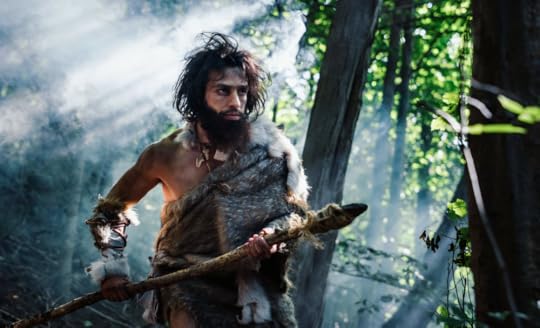
CREDIT: UNKNOWN / IF ANY ONE CAN IDENTIFY THS WORK, PLEASE CONTACT NFTF, SO WE CAN PROPERLY CREDIT
Several years later, Edgar B. Howard at the University of Pennsylvania had gotten wind that a road crew near Clovis, New Mexico had found a magnificent cache of huge mastodon bones. He rushed to the location. What he found, mingled among the monster bones were slender, finger-long and exquisitely carved spear points. They became known as Clovis Points, and for nearly 100 years were considered the oldest human-made spear points in North America. Since 1926, nearly 10,000 Clovis points , scattered in 1,500 locations all across the North America.
[image error]PHOTO CREDIT: OREGON STATE UNIVERSITY
For nearly a century it was accepted fact that the Clovis discoveries were the oldest known ancient artifacts in North America--around 12,800 to 13,500 years ago.
That is until just a couple of months ago. In December 2022, researchers from Oregon State University announced that unique spear points they had discovered near Cooper’s Ferry on the banks of the Salmon River in Idaho had been dated to around 16,000 years ago--3,000 years older than the oldest Clovis points--upending all we have assumed about when humans came to North America. The teams found 13 points points ranging from a half inch long to two inches long. The site is on traditional NEZ PERCE land near an ancient village known as Nipene.
That tracks with Nez Perce history, Nakia Williamson-Cloud, Cultural Resources Program Director for the NEZ PERCE tribe, told Science Magazine, the official publication of the American Association for the Advancement of Science. The
artifact filled site sits on NEZ PERCE land. Stories passed down over thousands
of years tell of a young couple establishing the village after a catastrophic flood destroyed their home across the river.
Although no genetic evidence connects the ancient toolmakers to modern Nez Perce people, Williamson-Cloud says he believes his tribe is “most definitely” their descendants. “These are truly our ancestors,” he says. “They aren’t just nameless Paleoindian people, and it’s not some nameless site. It’s a place where our lineage came from—people who are alive today.”
[image error]PICTURE CREDIT: OREGON STATE UNIVERSITY
That tracks with Nez Perce history, says Nakia Williamson-Cloud, Cultural Resources Program Director for the NEZ PERCE tribe, on whose lands the artifact-filled site sits. Stories passed down over thousands of years tell of a young couple founding the village after a catastrophic flood destroyed their previous home across the river.
Although no genetic evidence connects the ancient toolmakers to modern Nez Perce people, Williamson-Cloud says he believes his tribe is “most definitely” their descendants. “These are truly our ancestors,” he says. “They aren’t just nameless Paleoindian people, and it’s not some nameless site. It’s a place where our lineage came from—people who are alive today.”
What is particularly fascinating about discovery of these 13 spearpoints near that the same types of spearpoints that most closely resemble projectile points made by people who lived near modern-day Hokkaido, Japan, some 20,000 years ago.
Press the You Tube link below to view a short video produced by Oregon State University about the ground-breaking find:
https://youtu.be/CTlCsdwsBxkVIDEO CREDIT: OREGON STATE UNIVERSITY,An Even More Mind-Bending Discovery Puts the, Humans in North America 130,000 Years Ago,The discovery of the "Cerutti Mastodon" found in the suburbs of San Diego in the 1990s one of the most hotly contested discoveries in archeology. Studies continue, as do to debates between trained and amateur archeologists and archeology enthusiasts.
[image error]PHOTO CREDIT: SAN DIEGO NATURAL HISTORY MUSEUM / EARTHLY MISSIONThe above image shows the archeology site near San Diego. Below are some of the bones discovered and a depiction of a 130,00o-year-old mastodon.
[image error]PHOTO CREDIT: SAN DIEGO NATURAL HISTORY MUSEUM / EARTHLY MISSIONThe 130,000 monstrous beast appears to have been butchered by humans. Two archeology teams, one from the San Diego Natural History Museum and the Center for American Paleolithic Research. The were excited enough to discovery the massive skeleton, but when they began to analyze the bones more closely they were shocked that they found unique scraping marks and fractures that appeared--unbelievably--to be caused by humans. After extensive study and radiocarbon
dating, the results confirmed that the marks were caused by humans and an even more incredible fact: the mastodon bones were 130,000 years old!
[image error]PHOTO CREDIT: DANTHEMAN9758 / EARTHLY MISSIONlt surely upend history as we know it. But in these modern times and with the incredible advancements in archeology, accepted truths are turned upside down every day. History and history research is a moving target. Just has so much of medicine and biology and all the sciences have proved untrue so much of what the world believed in past centuries. I, for one, will keep an open mind. Let the research parse out the truth.
If you'd like to read more about the new discovery in Idaho or the amazing mastodon dig, click these links below:
SCIENCE MAGAZINE: Deadly Sharp Points Found in Idaho Could Be First American-Made ToolsTHE IDAHO STATESMAN: Stone dart tips found at Idaho site are oldest known weapons in Americas, experts say,https://www.idahostatesman.com/news/northwest/idaho/article270428672.html
THE ARCHEOLOGIST: New Evidence for Human Activity in North America 130,000 Years Ago,If you found this post interesting, you may be interested in this related Notes from the Frontier post:
,• Hunting Arrowheads,https://www.notesfromthefrontier.com/...
"When Did the First Humans Arrive in North America?" was first published on Facebook and ,NotesfromtheFrontier.com on Thursday, February 3, 2023.
©2023 NOTES FROM THE FRONTIER
[image error]January 14, 2023
Happy New Year - A Little Late

I guess I was anxious to get back in the saddle, after missing most of 2022 because of my kidney failure. I have so much more energy and am rarin' to go!
I hope to start posting regularly, at least twice a week and with some brand new posts. My "dogged" editor, Reggie, will be looking over my shoulder and making sure I keep my promises.
In the meantime, we hope you all have begun the new year in fine health and spirits.
As the great writer, C.S. Lewis, once said: “You are never too old to set another goal or to dream a new dream.” May this year bring you closer to your dreams. See you down the road...
Posted January 14, 2023.
You may also be interested in this related post:
July 2, 2022
Native Americans Celebrate July 4th by Honoring Their Glorious Military Tradition

July 4th is an American holiday that mixes honoring the birth of our nation with honoring our military. For Native Americans, the holiday has become a time to recognize their own indigenous warriors who, in modern times, have become well-known for their service in the U.S. military.
Most Americans do not realize that Native Americans have been decorated for bravery more per capita than any of ethnicity in our country. And they serve at greater numbers per capita than any other ethnicity.

On example of extraordinary American Indian service in our military was D-Day. About a month ago, we celebrated the 78th anniversary of D-Day. On June 7, 1944, more than 4,500 Allied troops, 2,000 of them American, were dead on the beaches of France. (Nine thousand would eventually be buried there.) They knew that the fate of the entire world depended on their bravery. Bless them. And here is a little known fact: nearly 500 Native American soldiers fought on Omaha and Utah Beach. (Some didn't even have the right to vote at home!)
The fate of the world also depended on a small group of Native Americans credited with helping turn the tide for the Allies: The Code-Breakers. In WWII, many were Navaho, but some were Lakota, Meskwaki, Mohawk, Comanche, and Tlingit. And here's a little known fact: the military employed 10,000 WOMEN codebreakers! Another little-known fact: WWII wasn't the first time the U.S. military used Native codebreakers. Cherokee, Choctaw, and Comanche code-talkers were first employed in WWI.

Partly because of their native language skills (which, ironically, the U.S. government had tried to crush for more than 80 years!), they were uniquely adept at breaking German and Japanese codes for strategic operations. The Code Talkers' contribution to the war efforts simply cannot be overstated.
Native American contributions to the U.S military have long been heralded. According to military statistics, Native Americans have served in the military more per capita than any other ethnic group. (Wanna guess who's a close second? African-Americans. Hispanic participation is also extremely high and growing.) Native Americans also have been decorated more for bravery (per capita) by the U.S. military than any other ethnic group: 25 Native Americans have received the Medal of Honor for heroism.

The warrior culture of some native tribes has long been celebrated in American popular culture. Bravery in battle was at a high premium in many tribes and was a main factor in male and chieftain status. (Modern research, as well as tribal oral histories, are revealing that Native WOMEN also served fiercely as warriors and as chiefs in the past. More on this in a later post. And record numbers of Native women join the armed forces today.)
The military has long recognized Native American contributions. In fact, Native American Eli Parker, the personal aide to General Ulysses S. Grant in the 1860s, was the first American Indian to reach the rank of General. (See Notes from the Frontier post, "Eli Parker: America's First Native American General.")
After World War II, the military named the first cruise missile in honor of the Navaho Code-Breakers: the SM-64 Navaho experimental cruise missile. That was the first of many war machines to be named after native tribes.
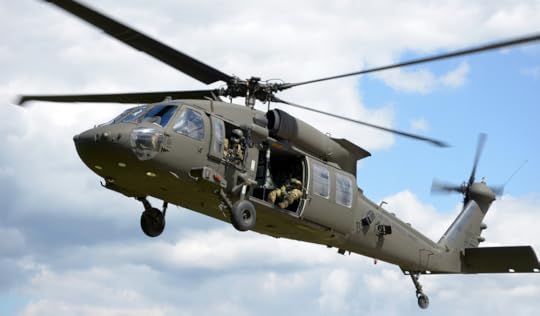
The military has a very complicated procedure to select Native American names for their military machines. First, the Bureau of Indian Affairs maintains a list of names the military can use, based on recommendations from tribal counsels. The Army Material Command chooses five names from that list, based on the characteristics of the helicopter, plane or other war machine. The name must promote dignity and inspire an aggressive spirit. Finally, the names are vetted through the United States Patent Office. (This brief list is only part of the bureaucratic process.)
Here's an official list of U.S. military machines with Native American names:
AIRCRAFT & MISSILES IN SERVICE:
AH-64 Apache attack helicopter UH-60 Black Hawk utility helicopter UH-72 Lakota utility helicopter CH-47 Chinook heavy-lift transport helicopter OH-58 Kiowa observation helicopter OH-6 Cayuse observation helicopter TH-67 Creek trainer helicopter C-12 Huron transport aircraft RU-21 Ute electronic intelligence aircraft, C-12 variant BGM-109 Tomahawk cruise missileRETIRED AIRCRAFT:
UH-1 Iroquois utility helicopter, retired in 2011 H-34 Choctaw transport helicopter, early 1970s RU-8 Seminole utility aircraft, 1992 H-21 Shawnee transport helicopter, 1967 OV-1 Mohawk twin-engine observation aircraft, 1996 T-41 Mescalero trainer aircraft, only for the Air ForcePROPOSED BUT NEVER FIELDED:
SM-64 Navaho experimental cruise missile, canceled 1957 AH-56 Cheyenne attack helicopter, abandoned 1972 RAH-66 Comanche attack helicopter, 2004 ARH-70 Arapaho armed reconnaissance helicopter, 2008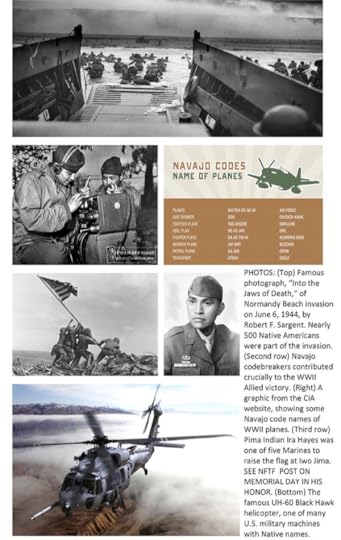
You may also enjoy this related post:
Ira Hayes: Remembering a Great American Warrior,https://www.notesfromthefrontier.com/post/ira-hayes-remembering-a-great-native-american-warrior
"Native American Military Tradition" was first published on Facebook and NotesfromtheFrontier.com June 7, 2019.
142,384 views / 1,832 likes / 428 shares / 269 comments
© 2022 NOTES FROM THE FRONTIER
May 21, 2022
A Modern-Day Tribute to Chief Joseph
I am so excited to share with Notes from the Frontier readers that I landed a Spirit Aligned grant of $175,000 for the Chief Joseph Foundation! As a writer, I've been volunteering grant-writing to the Chief Joseph Foundation to show my gratitude for their support of my upcoming novel, Blood to Rubies, about Chief Joseph and the 1877 Nez Perce War.
[image error]This grant was awarded to Nez Perce elder Bonnie Ewing (shown below to right of the circle map) and her granddaughter Lucy Samuels (middle, left). Both Nez Perce women trace their lineage back to Chief Twisted Hair who saved Lewis & Clark from starvation & freezing to death, built canoes for the expedition and showed them the way to the Northwest Passage.
[image error]Bonnie Ewing, now 84 years old, is a magnificent Nimiipuu elder who is passing down her traditional tribal knowledge to her granddaughter. She is an amazing Nez Perce woman who has ridden the Chief Joseph Trail Ride 28 times, taking Nez Perce youth along the path and showing them the battlefields where Joseph and his people fought to remain free. Retracing Joseph's path and that arduous 1,500-mile exodus, fighting and outsmarting the U.S. Army nearly all the way, is a crucial rite of passage for many Nez Perce youth.
[image error]To date, I have brought in $300,000 in grants for the Chief Joseph Foundation. You can learn more about the work that Bonnie does and the amazing mission of the Chief Joseph Foundation at: ,www.ChiefJosephFoundation.org
You may enjoy these related posts:
- In Honor of Chief Josephhttps://www.notesfromthefrontier.com/...
-The Chief Joseph Trail Ride,https://www.notesfromthefrontier.com/post/in-the-steps-of-chief-joseph
-The History of Appaloosas,https://www.notesfromthefrontier.com/post/the-history-of-appaloosas
"A Modern-Day Tribute to Chief Joseph" was first posted May 21, 2022 on Facebook and NotesfromtheFrontier.com
© 2022 NOTES FROM THE FRONTIER
November 27, 2021
Happy Native American Heritage Day
November is Native American Heritage Month and November 26, the day after our traditional Thanksgiving, is Native American Heritage Day. Here are two great links from Indian Country Today and Native Hope website about the background of Native American Heritage Day and how we can celebrate the magnificent heritage of our Native brothers and sisters.
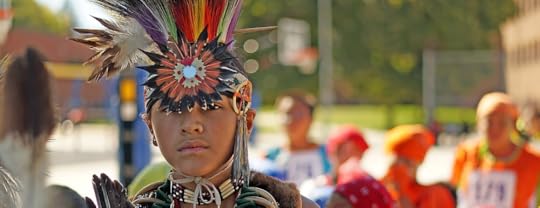
https://blog.nativehope.org/native-american-heritage-day
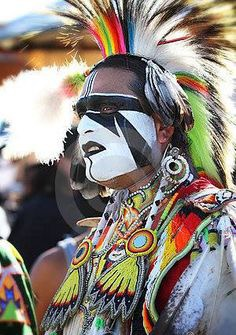
https://indiancountrytoday.com/
You may be interested in this related post:
• Native Americans: Back from the Brink,https://www.notesfromthefrontier.com//post/native-americans-back-from-the-brink
"Happy Native American Heritage Day" was first published on Facebook and ,NotesfromtheFrontier.com on Saturday, November 27, 2021.
127,384 views / 1,632 likes / 548 shares / 314 comments
©2021 NOTES FROM THE FRONTIER
October 13, 2021
The Mystery of Custer’s Horse, Vic, at the Little Bighorn
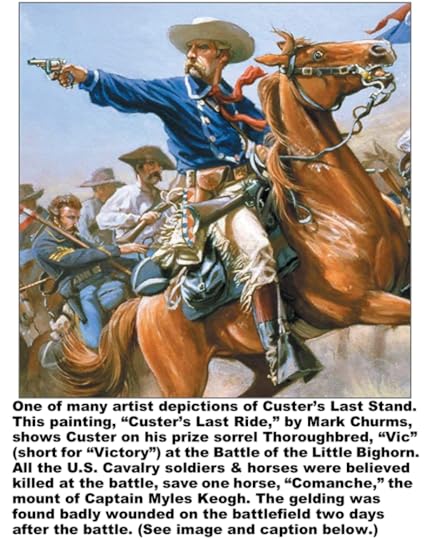
Few historical events generate more controversy than Custer and his last battle at the Little Bighorn (LBH). Among the many controversies is that of the fate of Custer’s prized Thoroughbred sorrel he called “Vic” (short for Victory). This author does not claim to know “the truth” about LBH and the fate of “Vic.” But a fascinating series of events, including the sudden appearance of alleged LBH artifacts in modern times, invite conjecture about one particular theory.

Custer had two horses in 1876. “Dandy” was a fifteen and a half hand Morgan mixed-breed, a dark bay with white nose and elongated star on his forehead. Custer liked Dandy for riding rough terrain and for hunting because he was sure-footed and agile. But for speed and spirit, particularly riding into battle, he preferred the younger and faster “Victory,” a Thoroughbred sorrel with three white socks, dark tail and mane, and a white blaze on his forehead.
On the morning of June 25, 1876, some historians believe Custer rode “Dandy” up to the “crow’s nest” where his scouts had been observing the Little Bighorn Valley. Custer was informed that the Sioux had discovered a box of hard tack that had fallen from the pack train and further observed the 7th. Having initially planned to rest the regiment for the day, Custer altered his plans and decided to attack instead of waiting. He therefore switched his mount and was riding “Vic” when the regiment moved out.
“Dandy” survived the battle and lived to a ripe old age of 26. Libbie Custer eventually returned Dandy to the Custer family in Michigan where Custer’s father was photographed on him.

The fate of Vic was more bloody. Although some Sioux claimed to have captured Vic alive, officers in Benteen’s command identified Custer’s sorrel among the dozens of dead horses shot by Cavalry soldiers to create a rifle bulwark on Custer Hill. Some historians believe it is likely Custer gave the order and shot his beloved Thoroughbred himself.
This post posits a fascinating theory: that Vic was killed at the LBH, most probably shot by Custer and his men--with dozens of other Cavalry horses—under orders to create a bulwark for soldiers in a last-ditch effort to defend themselves. The theory continues. Captain Benteen showed up two days after the battle and identified Custer and several officers claimed they identified the body of Vic, as well. It is possible, that when the soldiers hastily buried the nearly 250 human casualties of the battle, they buried Vic, as well, near his master?
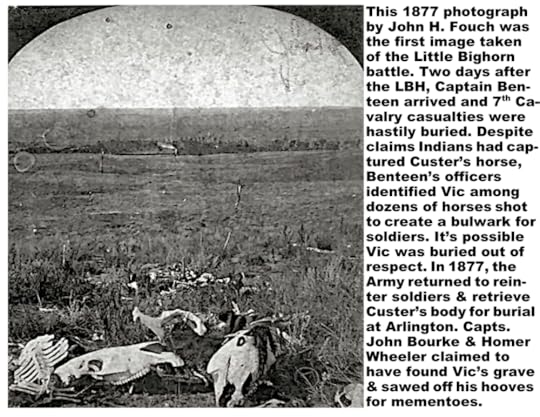
The theory doesn’t end there either. About a year later, the Army sent a detail to disinter the LBH victims and bury them in more permanent graves. The frontier photographer, John H. Fouch also took the first known photograph of battlefield, strewn with bones and horse skeletons. (See above.) Custer was disinterred and his body buried at Arlington Cemetery. It was during this gruesome expedition that two Cavalry officers, Captains Home Wheeler and John Bourke, claimed to have dug up Vic’s grave and sawed his hooves from his skeleton as mementoes. (In his critically-acclaimed, runaway bestseller about Custer, Son of the Morning Star, author Evan S. Connell writes of this incident. It was common in Victorian times to make inkwells and candlesticks using horse hooves as the base.)
Much later, Colonel Homer Wheeler became a very popular frontier author, in addition to his long Army career. In his popular 1923 book, Buffalo Days (I am lucky to have an actual copy of his book!), he writes on page 184:

[During the excursion to LBH in the summer of 1877] “We located the spot where Custer made his final stand. His brother, Tom Custer, ..., Custer’s nephew, Mark Kellogg,...and two or three of Custer’s officers were buried there. The remains of their dead horses were nearby. Captain Bourke and I cut off the hoofs of [Vic], the horse ridden by Custer, (a sorrel with three white fetlocks). Bourke had his pair made into inkstands and gave them to a Philadelphia museum. I placed mine in a grain sack and, being ordered out against the hostile Nez Perce in 1877 [against Chief Joseph], I left the sack in our wagons, which were lost.”
The legend does not end there either. More than a century later—128 years, in fact—two light colored horse hooves (the pigmentation of the hooves indicate the horse had white socks) mounted into sterling candlesticks showed up at a British auction house, Brightwell’s in Herefordshire, England, in 2005. (Brightwell’s was established in 1846 and is one of the world’s leading auction houses, serving many of Britain’s grand old estates and wealthiest collectors.)

The sterling silver encased hoof bases of the candlesticks bore the Roman numerals “VII,” embedded in both hooves. And the silver bases bore the date June 25, 1876, the date of the Battle of the Little Bighorn. It is believed that the embedded VII’s indicated Custer’s Seventh Cavalry. But they could have had yet another meaning. When Wheeler and Bourke found the graves at the Little Bighorn about a year after the battle, Custer’s grave and that of his brother, Tom, were marked with a “VI” and a “VII.” Because the graves were so hastily and shoddily marked, is it possible the grave-robbing captains mistook Tom Custer’s grave marked “VII” for his brother George’s grave? And was Vic buried near his ill-fated master? We will never know...
“The Mystery of Custer’s Horse, Vic” was first published on Facebook and NotesfromtheFrontier.com on October Wednesday, October 13, 2021.
You may also be interested in these related posts:
• Custer’s Black Hills Expedition of 1874https://www.notesfromthefrontier.com//post/custer-s-1874-black-hills-expedition
• Veterinary Care on Custer’s Campaigns,https://www.notesfromthefrontier.com//post/veterinary-care-on-custer-s-campaigns
©2021 NOTES FROM THE FRONTIER
October 9, 2021
Happy Indigenous People’s Day - Monday, October 10!



Below is a link to a great Smithsonian Magazine article about Indigenous People’s Day and the discussion involving the Columbus Day-Indigenous People’s Day issue:

Do you know what Native American tribes originally inhabited the land on which you live now? Go to this link to discover what tribes inhabited originally inhabited your home: https://native-land.ca/
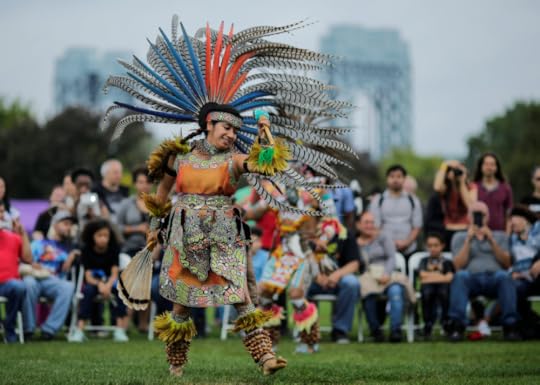
Below is a link to a wonderful article about the Indigenous People’s Day movement and how you can educate yourself and celebrate the day:
,https://www.culturalsurvival.org/news/11-things-do-indigenous-peoples-day

Below is a link to a comprehensive article from Parade Magazine about the evolution of Indigenous People’s Day:
,https://parade.com/1089776/jessicasager/what-is-indigenous-peoples-day/
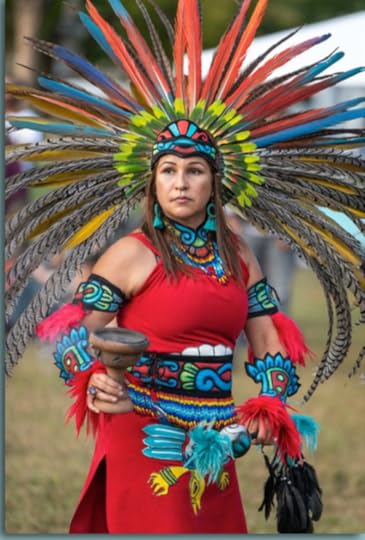
“Happy Indigenous People’s Day was first published on October 9, 2021 on Facebook and NotesfromtheFrontier.com
©2022 NOTES FROM THE FRONTIER
https://www.NotesfromtheFrontier.com
- Deborah Hufford's profile
- 42 followers



